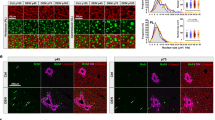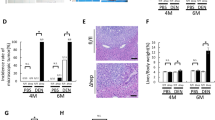Abstract
Comfrey is a rat liver toxin and carcinogen that has been used as a vegetable and herbal remedy by humans. In order to evaluate the mechanisms underlying its carcinogenicity, we examined the mutagenicity of comfrey in the transgenic Big Blue rat model. Our results indicate that comfrey is mutagenic in rat liver and the types of mutations induced by comfrey suggest that its tumorigenicity results from the genotoxicity of pyrrolizidine alkaloids in the plant.
Similar content being viewed by others
Main
Comfrey (Symphytum officinale) is a tall perennial plant with large hairy leaves and small purple flowers (Winship, 1991; Betz et al, 1994). Comfrey is consumed by humans as a vegetable and a tea. It has been used as an herbal medicine for more than 2000 years to treat broken bones, tendon damage, ulcerations in the gastrointestinal tract, lung congestion, and joint inflammation, and to promote wound healing (Rode, 2002). Comfrey, however, is hepatotoxic in livestock and humans and carcinogenic in experimental animals. It induced hepatic veno-occlusive disease in humans (Ridker et al, 1985; Weston et al, 1987; Bach et al, 1989; Ridker and McDermott, 1989; Yeong et al, 1990) and hepatocellular adenomas and haemangioendothelial sarcomas in rat liver (Hirono et al, 1978). Although there are no epidemiological data regarding the carcinogenicity of comfrey, these adverse effects have raised questions of its potential carcinogenicity in humans. This concern led the US Food and Drug Administration to request voluntary removal of products containing comfrey from the market in 2001 (FDA, 2001). There are presently, however, no restrictions on the use of comfrey in many parts of the world.
There is little known about the mechanism of tumour induction by comfrey. Although induction of hepatic tumours has been associated with the pyrrolizidine alkaloids (PAs) that are present in comfrey, and PAs are genotoxic and carcinogenic by binding to liver DNA in humans and animals (Prakash et al, 1999; Fu et al, 2004), a comprehensive study of comfrey mutagenesis has not been conducted. This inspired us to investigate the mutagenicity of comfrey in rat liver, a target tissue for its carcinogenesis, by using a transgenic rat mutational model (Dycaico et al, 1994).
In this study, we evaluated the mutagenicity of comfrey in the liver cII gene of Big Blue rats. The treatment schedule was based on a previous study that evaluated the carcinogenicity of comfrey (Hirono et al, 1978). Comfrey roots were obtained from Camas Prairie Products (Trout Lake, WA, USA). Pyrrolizidine alkaloids in the comfrey roots were determined by mass spectral analysis. The PAs detected were similar to those reported previously (Betz et al, 1994), and included symphytine, 7-acetyllycopsamine, and 7-acetylintermedine as major components in near equal amounts; intermedine and lycopsamine were present in relatively smaller quantity (data not shown). To determine an appropriate dose for treatment, a preliminary experiment was conducted by feeding diets containing 2, 4, and 8% comfrey. Based on a minimum effect on weight gain, lack of overt toxicity to the liver, and a maximum effect on mutagenicity, a diet containing 2% comfrey root was chosen for the mutagenesis experiment (see Supplements 1 and 2). The comfrey roots were ground and then blended with basal diet powder (NIH-31 pellets, Purina Mills International, Brentwood, MO, USA) in a Hobart Mixer to make a 2% comfrey root diet. Groups of six 6-week-old male Big Blue rats (Taconic Laboratories, Germantown, NY, USA) were fed either a basal diet or the comfrey diet. The animals were killed after 12 weeks of treatment.
Mutant frequencies (MFs) were determined for the liver cII gene of the rats treated with comfrey (Table 1). The MF for rats fed comfrey was 146±15 × 10−6, which was significantly greater than the MF for control rats, 30±16 × 10−6 (P<0.001, ANOVA, Holm–Sidak test). In the previous study of the carcinogenic activity of comfrey (Hirono et al, 1978), rats receiving a diet containing 2% comfrey root had a 42% incidence of liver tumours, while no liver tumours were found in the control rats. This correspondence between mutation induction and tumour induction suggests that comfrey induces liver tumours through a genotoxic mechanism.
The mechanisms by which the carcinogenicity and mutagenicity of comfrey are produced are not fully understood. Although we encountered no overt signs of liver toxicity in our relatively short-term study, the liver histology of rats fed comfrey for prolonged periods is quite similar to that produced by some hepatotoxic PAs (Schoental, 1968; Hirono et al, 1976, 1977). Liver cell necrosis, haemorrhage, bile duct proliferation, and liver cirrhosis are frequently encountered even in rats from experimental groups that have no tumours. This suggests that the liver tumours in comfrey-treated rats might be induced by the PAs present in comfrey. Indeed, comfrey contains up to nine PAs (Stickel and Seitz, 2000; Kim et al, 2001; Schaneberg et al, 2004), at least two of which, symphytine and lasiocarpine, are carcinogenic when administered as pure compounds (Svoboda and Reddy, 1974; Hirono et al, 1979).
Recently, we investigated the mutagenicity of riddelliine, a representative genotoxic PA, in Big Blue rat liver. The most common mutation induced by riddelliine was G:C → T:A transversion; however, an unusually high frequency of tandem base substitution was also found (Mei et al, 2004). Since it has been suggested that all PAs produce the same types of DNA adducts (Fu et al, 2004), we hypothesised that if the PAs in comfrey were responsible for its mutagenicity, the mutational spectrum of comfrey should be similar to that induced by riddelliine. Therefore, we sequenced 211 mutants from comfrey-treated rats and 63 mutants from control rats. A total of 200 and 46 independent mutations were identified from the treated and control animals, respectively. The types of mutations detected are summarised in Table 2 and compared with cII mutations isolated from the livers of riddelliine-treated rats. Statistical evaluation of these spectra (Adams and Skopek, 1987) indicates that the spectrum from comfrey-fed rats is significantly different from the control (P<0.001), while there is no significant difference between the spectra induced by comfrey-treated and riddelliine-treated rats (P>0.05). G:C → T:A transversion (42%) was the major type of mutation in comfrey-fed rats, whereas G:C → A:T transition (43%) was the predominant mutation in the controls. In addition, an unusually high frequency of tandem base substitutions (17%) was observed among the mutations from comfrey-fed rats. Tandem base substitution has been suggested as a mutational signature for the genetic damage of PAs (Mei et al, 2004). Therefore, these mutational data support the hypothesis that the mutations induced by comfrey in rat liver are due to PAs in the comfrey.
In conclusion, treatment of transgenic Big Blue rats with comfrey induced mutations in the liver cII gene. This result suggests that comfrey induces liver tumours by a genotoxic mechanism. The mutational spectrum from comfrey-treated rats suggests that PAs in the plant are responsible for mutation induction and tumour initiation in rat liver.
Change history
16 November 2011
This paper was modified 12 months after initial publication to switch to Creative Commons licence terms, as noted at publication
References
Adams WT, Skopek TR (1987) Statistical test for the comparison of samples from mutational spectra. J Mol Biol 194: 391–396
Bach N, Thung SN, Schaffner F (1989) Comfrey herb tea-induced hepatic veno-occlusive disease. Am J Med 87: 97–99
Betz JM, Eppley RM, Taylor WC, Andrzejewski D (1994) Determination of pyrrolizidine alkaloids in commercial comfrey products (Symphytum sp.). J Pharm Sci 83: 649–653
Dycaico MJ, Provost GS, Kretz PL, Ransom SL, Moores JC, Short JM (1994) The use of shuttle vectors for mutation analysis in transgenic mice and rats. Mutat Res 307: 461–478
FDA (2001) FDA advises dietary supplement manufacturers to remove comfrey products from the market. USFDA, Center for Food Safety and Applied Nutrition. http://vm.cfsan.fda.gov/~dms/dspltr06.html
Fu PP, Xia Q, Lin G, Chou MW (2004) Pyrrolizidine alkaloids – genotoxicity, metabolism enzymes, metabolic activation, and mechanisms. Drug Metab Rev 36: 1–55
Hirono I, Haga M, Fujii M, Matsuura S, Matsubara N, Nakayama M, Furuya T, Hikichi M, Takanashi H, Uchida E, Hosaka S, Ueno I (1979) Induction of hepatic tumors in rats by senkirkine and symphytine. J Natl Cancer Inst 63: 469–472
Hirono I, Mori H, Culvenor CC (1976) Carcinogenic activity of coltsfoot, Tussilago farfara L. Gann 67: 125–129
Hirono I, Mori H, Haga M (1978) Carcinogenic activity of Symphytum officinale. J Natl Cancer Inst 61: 865–869
Hirono I, Mori H, Yamada K, Hirata Y, Haga M (1977) Carcinogenic activity of petasitenine, a new pyrrolizidine alkaloid isolated from Petasites japonicus Maxim. J Natl Cancer Inst 58: 1155–1157
Kim NC, Oberlies NH, Brine DR, Handy RW, Wani MC, Wall ME (2001) Isolation of symlandine from the roots of common comfrey (Symphytum officinale) using countercurrent chromatography. J Nat Prod 64: 251–253
Mei N, Heflich RH, Chou MW, Chen T (2004) Mutations induced by the carcinogenic pyrrolizidine alkaloid riddelliine in the liver cII gene of transgenic Big Blue rats. Chem Res Toxicol 17: 814–818
Prakash AS, Pereira TN, Reilly PE, Seawright AA (1999) Pyrrolizidine alkaloids in human diet. Mutat Res 443: 53–67
Ridker PM, McDermott WV (1989) Comfrey herb tea and hepatic veno-occlusive disease. Lancet 8639: 657–658
Ridker PM, Ohkuma S, McDermott WV, Trey C, Huxtable RJ (1985) Hepatic venocclusive disease associated with the consumption of pyrrolizidine-containing dietary supplements. Gastroenterology 88: 1050–1054
Rode D (2002) Comfrey toxicity revisited. Trends Pharmacol Sci 23: 497–499
Schaneberg BT, Molyneux RJ, Khan IA (2004) Evaporative light scattering detection of pyrrolizidine alkaloids. Phytochem Anal 15: 36–39
Schoental R (1968) Toxicology and carcinogenic action of pyrrolizidine alkaloids. Cancer Res 28: 2237–2246
Stickel F, Seitz HK (2000) The efficacy and safety of comfrey. Public Health Nutr 3: 501–508
Svoboda DJ, Reddy JK (1974) Laslocarpine-induced, transplantable squamous cell carcinoma of rat skin. J Natl Cancer Inst 53: 1415–1418
Weston CF, Cooper BT, Davies JD, Levine DF (1987) Veno-occlusive disease of the liver secondary to ingestion of comfrey. BMJ (Clin Res Ed) 295: 183
Winship KA (1991) Toxicity of comfrey. Adverse Drug React Toxicol Rev 10: 47–59
Yeong ML, Swinburn B, Kennedy M, Nicholson G (1990) Hepatic veno-occlusive disease associated with comfrey ingestion. J Gastroenterol Hepatol 5: 211–214
Acknowledgements
This research was partly supported by an appointment (NM) to the Postgraduate Research Program at the NCTR administered by the Oak Ridge Institute for Science and Education.
Author information
Authors and Affiliations
Corresponding author
Additional information
The views presented in this article do not necessarily reflect those of the US Food and Drug Administration
Supplementary Information accompanies the paper on British Journal of Cancer website (http://www.nature.com/bjc).
Supplementary information
Rights and permissions
From twelve months after its original publication, this work is licensed under the Creative Commons Attribution-NonCommercial-Share Alike 3.0 Unported License. To view a copy of this license, visit http://creativecommons.org/licenses/by-nc-sa/3.0/
About this article
Cite this article
Mei, N., Guo, L., Fu, P. et al. Mutagenicity of comfrey (Symphytum Officinale) in rat liver. Br J Cancer 92, 873–875 (2005). https://doi.org/10.1038/sj.bjc.6602420
Revised:
Accepted:
Published:
Issue Date:
DOI: https://doi.org/10.1038/sj.bjc.6602420
Keywords
This article is cited by
-
Transgenic rat models for mutagenesis and carcinogenesis
Genes and Environment (2017)
-
Cytotoxicity, genotoxicity and mechanism of action (via gene expression analysis) of the indole alkaloid aspidospermine (antiparasitic) extracted from Aspidosperma polyneuron in HepG2 cells
Cytotechnology (2016)
-
Comparison of gene expression profiles altered by comfrey and riddelliine in rat liver
BMC Bioinformatics (2007)
-
Analysis of gene expression changes in relation to toxicity and tumorigenesis in the livers of Big Blue transgenic rats fed comfrey (Symphytum officinale)
BMC Bioinformatics (2006)
-
Rat toxicogenomic study reveals analytical consistency across microarray platforms
Nature Biotechnology (2006)



